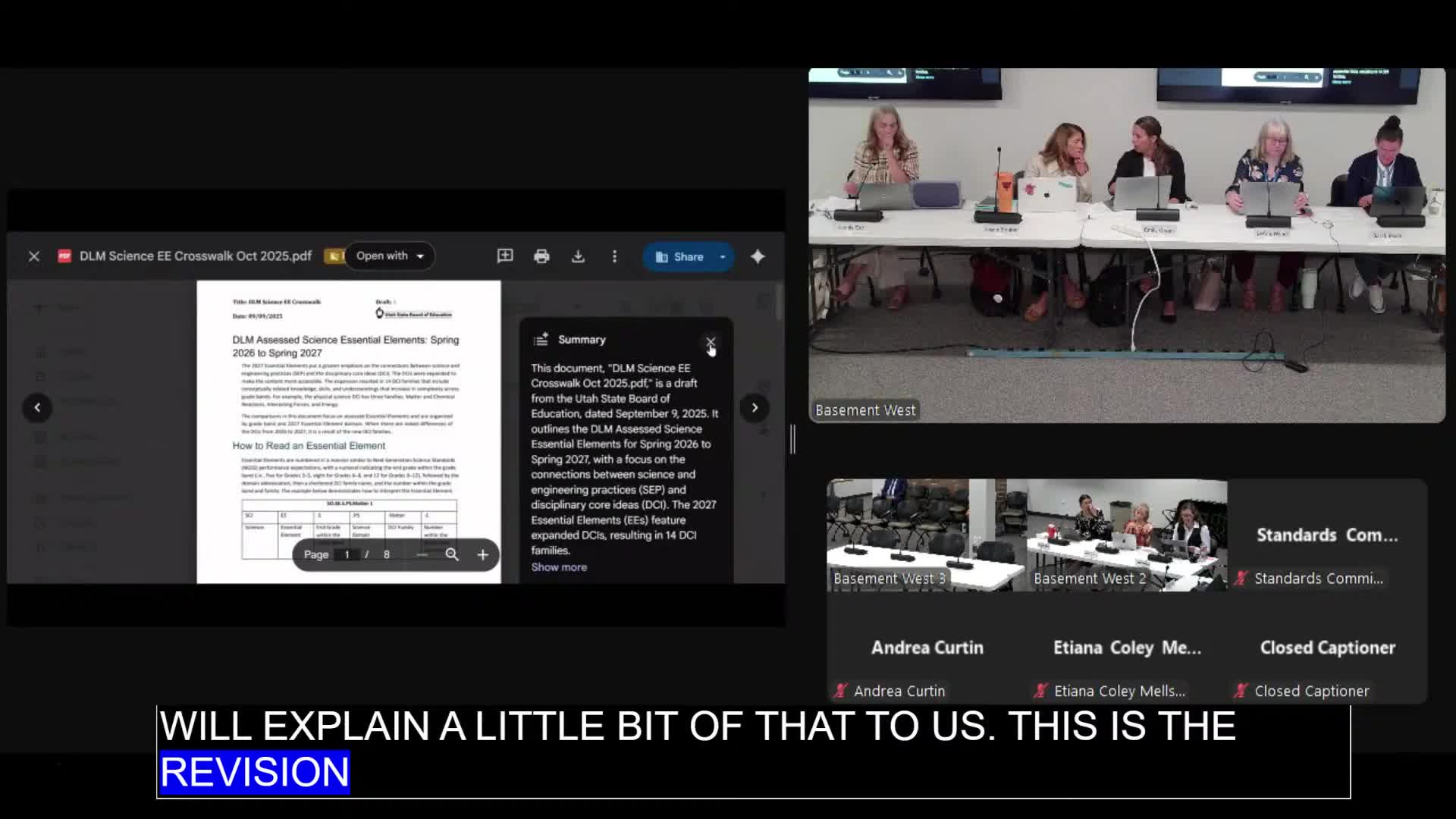Committee approves Dynamic Learning Maps revision for alternate science standards; staff to provide additional instructional guidance
This article was created by AI summarizing key points discussed. AI makes mistakes, so for full details and context, please refer to the video of the full meeting. Please report any errors so we can fix them. Report an error »

The Standards and Assessment Committee voted to approve the Dynamic Learning Maps (DLM) consortium’s proposed revisions to the alternate achievement science standards and will forward the revisions to the full Utah State Board of Education for final approval.
Deputy Superintendent Lia Voorhees explained the federal and state context for alternate achievement standards: under the Individuals with Disabilities Education Act (IDEA) and state rule R277-750, states may adopt alternate standards and aligned assessments for students with the most significant cognitive disabilities. Voorhees noted the Elementary and Secondary Education Act (ESSA) limits the proportion of students assessed with alternate assessments to 1 percent or fewer.
Tracy Gulley, special education assessment specialist, said the DLM crosswalk in the meeting backup shows prior essential elements and the updated 26 essential elements that will be operational and assessed next year. “The crosswalk … the 26 ones are the updated ones that will actually go into what they call operation or be tested and instructed next year,” she said.
Committee discussion focused on accessibility and teachability for the target student population. Board members asked how the essential elements align with the three-dimensional structure of the core science standards (science and engineering practices, crosscutting concepts and disciplinary core ideas) and how teachers will access instruction for students with significant cognitive disabilities. Tanya Semerad, the autism and significant cognitive disability specialist, said the essential elements and DLM resources include multiple “access points” that backward-map the standard into simpler precursor skills so teachers can scaffold instruction.
After discussion, a committee member moved to approve the DLM revision and forward it to the board; the committee recorded the motion as passed unanimously. “I move the committee approve the DLM alternate achievements science standards revision and forward to the board for final approval,” the mover said. The committee chair called for the vote; members responded “Aye,” and Voorhees said the motion passed unanimously.
Why it matters: Alternate achievement standards govern instruction and assessment for a small subset of students with the most significant cognitive disabilities. The committee’s approval advances the planned assessment and instructional alignment for that population.
Next steps and staff follow-up
- Staff will provide committee members with additional instructional examples, “mini-maps” and sample assessment items to clarify how the essential elements translate into teachable skills and measurable tasks.
- The committee asked staff to return with materials showing access points and sample items to support teachers before final board action.
Ending: The committee approved the DLM revisions and forwarded them to the board; staff agreed to circulate additional instructional resources to help teachers and committee members evaluate implementation.
Deputy Superintendent Lia Voorhees explained the federal and state context for alternate achievement standards: under the Individuals with Disabilities Education Act (IDEA) and state rule R277-750, states may adopt alternate standards and aligned assessments for students with the most significant cognitive disabilities. Voorhees noted the Elementary and Secondary Education Act (ESSA) limits the proportion of students assessed with alternate assessments to 1 percent or fewer.
Tracy Gulley, special education assessment specialist, said the DLM crosswalk in the meeting backup shows prior essential elements and the updated 26 essential elements that will be operational and assessed next year. “The crosswalk … the 26 ones are the updated ones that will actually go into what they call operation or be tested and instructed next year,” she said.
Committee discussion focused on accessibility and teachability for the target student population. Board members asked how the essential elements align with the three-dimensional structure of the core science standards (science and engineering practices, crosscutting concepts and disciplinary core ideas) and how teachers will access instruction for students with significant cognitive disabilities. Tanya Semerad, the autism and significant cognitive disability specialist, said the essential elements and DLM resources include multiple “access points” that backward-map the standard into simpler precursor skills so teachers can scaffold instruction.
After discussion, a committee member moved to approve the DLM revision and forward it to the board; the committee recorded the motion as passed unanimously. “I move the committee approve the DLM alternate achievements science standards revision and forward to the board for final approval,” the mover said. The committee chair called for the vote; members responded “Aye,” and Voorhees said the motion passed unanimously.
Why it matters: Alternate achievement standards govern instruction and assessment for a small subset of students with the most significant cognitive disabilities. The committee’s approval advances the planned assessment and instructional alignment for that population.
Next steps and staff follow-up
- Staff will provide committee members with additional instructional examples, “mini-maps” and sample assessment items to clarify how the essential elements translate into teachable skills and measurable tasks.
- The committee asked staff to return with materials showing access points and sample items to support teachers before final board action.
Ending: The committee approved the DLM revisions and forwarded them to the board; staff agreed to circulate additional instructional resources to help teachers and committee members evaluate implementation.
View full meeting
This article is based on a recent meeting—watch the full video and explore the complete transcript for deeper insights into the discussion.
View full meeting